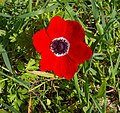Etymology
Anemone coronaria means crown anemone, referring to the central crown of the flower, evoking regal associations. The Arabic name is shaqa'iq An-Nu'man translated literally as the wounds, or "pieces", of Nu'man. [6] [7]
A possible source of the name is An-Nu'man III Bin Al-Munthir, the last Lakhmid king of Al-Hirah (582–c.609 AD) and a Christian Arab. An-Nu'man is known to have protected the flowers during his reign. [6] According to legend, the flower thrived on An-Nu'man's grave, after his death in the battle against the Sassanids, paralleling the death and rebirth of Adonis.
Another possible source of the name traces back to the Sumerian god of food and vegetation, Tammuz, whose Phoenician epithet was "Nea'man". [8] Tammuz is generally considered to have been drawn into the Greek pantheon as Adonis, who died of his wounds while hunting wild boar. The deity is transformed into a flower, stained by the blood of Adonis. [8] Tammuz's Phoenician epithet "Nea'man" is believed to be both the source of "an-Nu'man" in Arabic which came through Syriac, and of "anemone" which came through Greek. [8]
In Hebrew, the anemone is kalanit metzuya . "Kalanit" comes from the Hebrew word "kala כלה" which means "bride", "metzuya" means "common." The kalanit earned its name because of its beauty and majesty, evoking a bride on her wedding day. [9] In 2013 Anemone coronaria was elected as the national flower of the State of Israel, in a poll arranged by the Society for the Protection of Nature in Israel (החברה להגנת הטבע) and Ynet. [10] Each year in Israel there is a month-long festival to celebrate the blooming of the red anemones. [11] During the British Mandate for Palestine, British paratroopers were nicknamed "kalaniyot" for their red berets. [12]
It is also a symbol of Palestine, with its colors evoking the Palestinian flag. [13]













